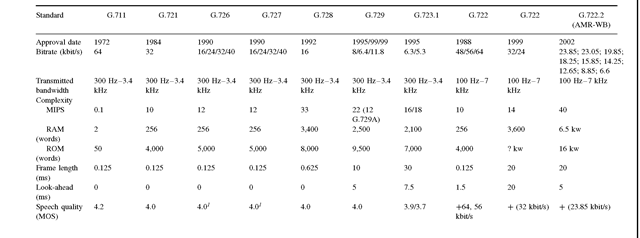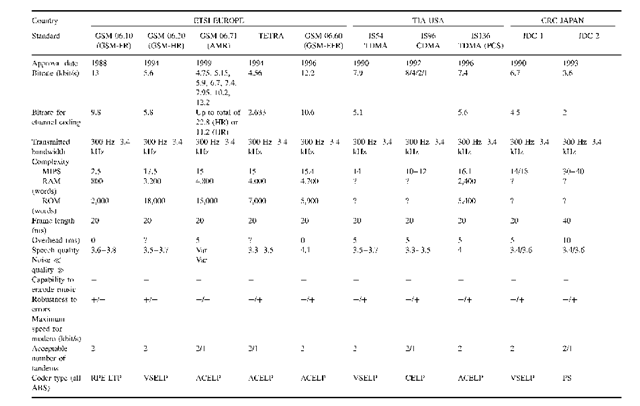2.11
2.11.1
Main characteristics of ITU-T standardized speech coders
| 0-48 kbit/s2 | 0 (24 kbit/s) | -(6.6 kbit/s) | ||||||||
| Noise ‘quality’ | + | + | +’ | +’ | + | 0 | - | +2 | +/0 | + |
| Capability to | 0 | 0 | 0> | 0> | 0 | - | - | + 64 kbit/s2 | + | -10 |
| encode music | 0 56 kbit/s -48 kbit/s | |||||||||
| Robustness to | 0/0 | +/0 | +/01 | +I01 | 0/- | +/+ | 0/0 | +/0 | - | -10 |
| errors | ||||||||||
| Maximum | 28.8 | 4.8 | 14.43 | 14.43 | 2.4 | — | — | — | — | — |
| speed for | ||||||||||
| modem (kbit/s) | ||||||||||
| Number of | 14 | 4 | 4′ | 4′ | 3 | 2 | 2/1 | 3 | 2 | 2 |
| acceptable | ||||||||||
| tandems | ||||||||||
| Coder type | Waveform | Waveform | Waveform | Waveform | ABS | ABS | ABS | Waveform | LCTC | ACELP |
| PCM | ADPCM | ADPCM | ADPCM embedded | LD-CELP | CS-ACELP | MP-MLQ ACELP | SB-ADPCM |
1 Quality for 32 kbit/s. At 16 kbit/s and 24 kbit/s, continuous use is not recommended. At 40 kbit/s, the MOS is 4.2.
2MOSs do not have the same meaning for a wide-band signal. The reference is a wide-band (10-7,000 Hz) signal and the following scale will be used: + : near the original, good; 0: medium quality; — : poor quality
3 Possible with a bitrate of 40 kbit/s.
Note: Because of the processing delay on limited power processors, the total observed delay is around several samples (3 to 4) for waveform-type coders (but for G.722 QMF filters add 3 ms). For the ABS-type speech coder, the total delay is around four times the frame length (+ overhead if present).
2.11.2


